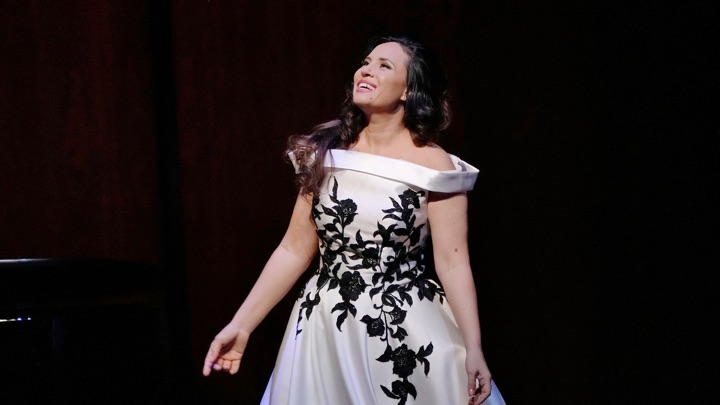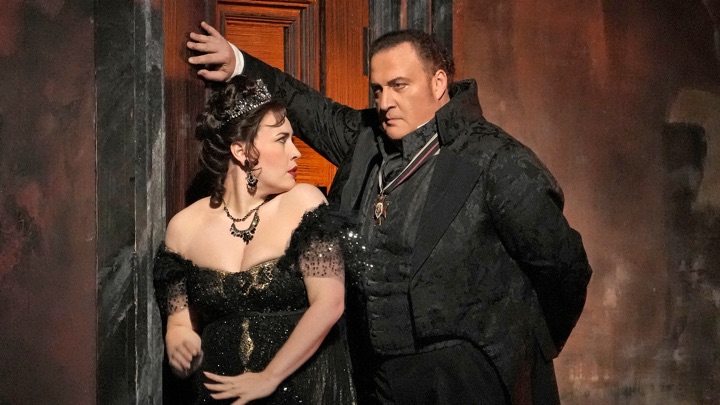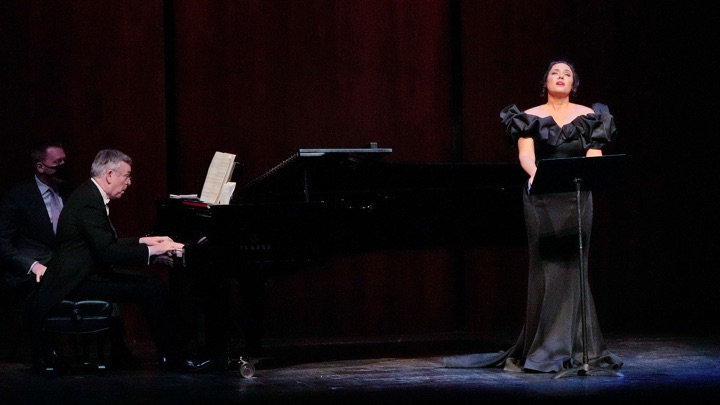

Only one however, revealed the qualities that separate a diva from a skilled soprano.
Russian-born Elena Stikhina returned to the Met as Floria Tosca after making her debut in the title role of Suor Angelica in December 2018. Since that striking debut, Stikhina has toured the world in roles like Aida, Salome and Tosca at international opera houses.
This season alone, Stikhina is singing Tosca at the Met, Covent Garden, and Vienna State Opera. Joseph Calleja returned to the house as Mario Cavaradossi having sung the role twice before in 2018 and 2019. George Gagnidze as Scarpia and conductor Carlo Rizzi are seasoned Tosca veterans with dozens of Met performances under their belt.
However, on January 14th, the second show of this run, the lead performers seemed to barely know or care about what the opera was about. Initially Rizzi conducted deliberately but with fine orchestral detail. However, as the evening progressed, the singers began to slow down the tempos and he doggedly followed them.
As the performance increasingly turned musically and dramatically flaccid, the soloists persistently lagged behind the beat. It gave the impression of delayed reactions like they were all on Xanax and only intermittently plugged into reality. The vocal sound seemed to come first, then text and drama lagged far behind. Verismo style was nowhere in sight.
David McVicar’s traditional production is a neutral element—take away the tilted floors and Zinka Milanov and Richard Tucker would be perfectly at home in it. Put onstage three vocal and dramatic firecrackers in the leading roles and you would have a great evening—but with the three damp squibs the Met cast it didn’t hinder or help anyone.
Neither of the leading men were in their best voice. Calleja has never convinced me as a Puccini tenor—his heady, soft-spun tenor is big enough for Puccini but his “caprino” vibrato turns into a bleat under pressure while his high notes lack focus and squillo. Calleja has a rather backward voice production avoiding focused hard palate projection—that can work in bel canto and French roles but not dramatic Italian opera. Act III showed the Maltese tenor at his best: “E lucevan le stelle” revealed beautiful dynamic control with controlled diminuendos and sustained piano singing on the phrase “Le belle forme disciogliea dai veli!”
“O dolci mani” was as tender and delicate as one could wish. However, heroic high phrases like “Vittoria! Vittoria!” in Act II turned into tonally opaque bleats. An affable but low-key actor, Calleja did not compensate with much emotional commitment or projection of personality.
Gagnidze, usually reliably loud and juicy of tone, seemed to be ill or recovering from illness. His booming baritone sounded smallish and covered. He was unusually low energy and disengaged dramatically as were his colleagues.
Stikhina made a visually and vocally girlish Roman diva. Petite with a heart-shaped face, large eyes and long dark curls framing her pretty face, this Tosca seemed more ingenue than imposing prima donna. The middle register lacks distinctive color, breadth and expression and her lower register is weak. Stikhina’s voice opens up on top – she scored points with loud, accurate and easy high B’s and C’s on phrases like “Ah più non reggo” in Act II and “Io quella lama gli piantai nel cor” in Act III.
Stikhina never forces the tone or reverts to shouting or screaming—everything is sung. Her diction is covered with minimal textual emphasis—she doesn’t use rubato so her phrasing is all rather plain lacking contrast. “Vissi d’arte” was miscalculated—Stikhina perhaps thought the aria needed to be vocally reined in to give it intimacy. However, given that her voice lacks breadth and tonal amplitude in the vast Met auditorium, her big aria emerged vocally underpowered and tonally undernourished—sing out Floria!
Acting-wise, Stikhina was coquettish in Act I—Tosca’s jealousy was more flirtatious teasing than neurotic insecurity or prima donna hauteur. Act II was played too passive. Stikhina could not sustain dramatic tension being rarely spontaneous or in the moment.
Too often she sat calmly on the settee as if she was waiting for a bus. In general, theatrically there was a lack of stakes: this Tosca didn’t seem to love Mario desperately enough, wasn’t sufficiently frightened or repulsed by Scarpia and lacked a sense of personal degradation. Therefore, nothing about her situation seemed worth getting upset about, let alone killing for.
Stikhina’s Tosca reminded me of Mirella Freni circa 1971 when she was starting to take on heavier rep: girlish charm, absolutely no vocal problems but displaying a certain homogenized blankness in the interpretation. Unlike Stikhina, Freni had Puccini style with stylish phrasing and clear native Italian diction. Freni, despite being a Puccini specialist, avoided performing Tosca onstage relegating it to the recording studio only. Other early and middle period Freni roles probably could work for Stikhina—Liù, Mimi, Amelia in Simon Boccanegra and Tatyana in Onegin.
All in all, Stikhina is just miscast. Stikhina is a good singer but no diva. Hers is a well-produced healthy voice that is tonally attractive if generic in timbre. I wouldn’t mind hearing her again in more lyric repertoire—her personality and voice are too small and the Met auditorium too large for her to command. To be a diva rather than just play one you need personal charisma, a distinctive timbre, dramatic commitment and something personal to bring to the piece.
When the McVicar Tosca production premiered in 2017, the beautiful Bulgarian Sonya Yoncheva was drafted at the last minute to make her role debut as Floria Tosca. Her precipitous assumption of this demanding diva role showed Yoncheva’s eagerness to expand her repertory from the baroque and classical roles of her early career to dramatic soprano roles like Cherubini’s Medée and Bellini’s Norma.
The Metropolitan Opera also was eager to promote Yoncheva as a new soprano star to showcase in new productions and gala evenings. A very hot new property on the international opera scene, Yoncheva was adding as many as four or five new roles to her repertoire each season—not only Tosca but Imogene in Bellini’s Il Pirata, Puccini’s Manon Lescaut, Élisabeth de Valois in Verdi’s Don Carlos as well as role debuts as Verdi’s Luisa Miller and Desdemona in Otello at the Met.
The stress began to show as documented on Met HD transmissions and radio broadcasts. At her 2013 debut as Gilda, Yoncheva revealed a unique voice of individual beauty—almost two different voices blended into a harmony of contrasts. There was a radiant silvery soprano core that soared in pianos and high-lying cantilena but it was surrounded by dark, plush mezzo-toned velvet—almost like a black mink coat lined with silver cloth.
At the Met, Yoncheva was exquisite as Mimi in La Bohème in 2014 and Violetta in La Traviata in 2015. However, role repeats for the HD cameras in 2017 and 2018 documented loosening vibrato, blowzy tone and shrill high notes. The most shocking contrast in vocal quality was her radiant Desdemona in the new production premiere of Otello in 2015 and the superannuated wobbly, worn tones heard in the January 2019 radio broadcast of the revival.
Luisa Miller at the Met and Il Pirata at La Scala were equivocal role assumptions with omitted high notes and simplified coloratura helping her avoid vocal pitfalls. The plush dark velvet in her tone lost focus and became grainy while the silver soprano core turned into edgy glare and tonal edge.
The forced hiatus imposed by suspension of performances during the COVID-19 pandemic had some collateral advantages. Singers who were pushing themselves toward vocal burnout were forced to stop, rest, reconsider and retrain. Yoncheva returned to the Metropolitan Opera stage on Sunday evening January 23 in a vocal recital of French and Italian songs accompanied by pianist Malcolm Martineau.
Yoncheva entered smiling looking radiant in a metallic black silk evening gown with large ruffles around the shoulders, her raven hair swept up in a becoming loose chignon. She was greeted by a less than full but appreciative crowd in the Met auditorium. Yoncheva circa 2022 at age 40 is a very beautiful woman with a gracious manner, interpretive insight and great musicality.
Her instrument has many of its beauties restored by vocal rest but also lingering remnants of the damage of too much too soon. The middle register has darkened but regained its plush dark timbre and tonal point. The silver core still turns to harsh edginess in floated pianissimos or pushed in high-lying phrases where the vibrato loosens. Luckily many of the French songs were centered in the middle register and featured soft or medium dynamics that presented her current voice in its best light.
Despite the fact that Yoncheva has been touring this recital program internationally for months, she used a music stand placed in front of her. This increasingly common trend of not memorizing the program and depending on sheet music is less than ideal for communication—the eyes travel downward to refer to the score and the stand blocks half the singer’s body including the hands. This is a shame because Yoncheva has beautiful expressive eyes and hands and was deeply connected to the material finding specific moods for each song.
This was evident in the French group of Duparc, Viardot and Chausson chansons almost all of which were reflective, often lovelorn with an overall mood of melancholy introspection. Yoncheva’s French diction has hardly a trace of a Slavic accent—she received vocal training in Geneva and early in her career gained stage experience in Paris as a member of Le Jardin des Voix with Les Arts Florissants under William Christie. She not only pronounces French correctly but can think in French therefore putting the correct intention into the text.
The Duparc group consisting of “L’invitation au voyage”, “Au pays où se fait la guerre”, “La vie antérieure” and “Chanson triste” were marked by subtle shifts of mood and vocal color. The expressive tone and dark timbre suited the intimately sorrowful texts.
Yoncheva’s expansive voice and dramatic conviction made these miniature pieces into confessional monologues that drew the listener in even in such a large space as the Met auditorium. Pauline Viardot’s faux folk ballad “Haï luli!” and Chausson’s “Le temps des lilas”, from his Poème de l’Amour et de la Mer throbbed with heartbreak and loss of love. Despite the pervasive dark introspective mood, Yoncheva found contrast and specificity in the material.
The Donizetti French song “Depuis qu’une autre a su te plaire” was more outspoken about the betrayal of love with a certain Mlle. Malvina dispatching her fickle lover with a definite touch of bitterness. Her first half closer, Leo Delibes’ familiar soprano espagnolerie “Les filles de Cadix”, sparkled extra bright because Yoncheva lightened her mood while lightening her voice for the florid sections and danced around stage no longer trapped behind her music stand.
Throughout the program Yoncheva lavished the superb Malcolm Martineau with loving gazes, smiles and personally directed applause. Martineau revels in the translucent and cut-glass delicacy of these impressionistic French composers, highlighting every subtle detail while adding surprising rubato touches. The variety of details, moods and colors made one not miss the orchestration in the Chausson Po?me de l’Amour et de la Mer.
Yoncheva returned after intermission changed into a low-cut white silk evening gown with the bodice embroidered with black roses, her equally black hair worn down and loose around her ivory shoulders. The second half featured Italian songs by familiar opera composers like Puccini and Verdi and the salon master Paolo Tosti along with the lesser-known Giuseppe Martucci.
Yoncheva’s voice in Italian song repertoire was more open, less reined in with warmer tones. Several songs ended with full-voiced high note climaxes that were boldly attacked emerging full, secure and round-toned. The Italian texts were projected forcefully with more extroverted personality.
The early Puccini songs composed during his bohemian salad days (“Sole e amore”, “Terra e mare”, “Mentia l’avviso” and “Canto d’anime”) were adapted and revised into the score of La Bohème. This summoned pleasant memories of Yoncheva’s early Met Mimi. One could hear the influence of Debussy and impressionism on Puccini’s musical development but also sunny Italian lyricism and lilting melodies that Puccini expanded in his later operas.
Giuseppe Martucci, a contemporary of Puccini, revealed a distinct musical personality in “Al folto bosco, placida ombria” showing the influence of his German idols Richard Wagner and Johannes Brahms. The style was more classical in this strophic ballad. It is a shame Martucci never wrote operas because his setting of the text was quite theatrical and specific. Tosti’s “L’ultimo bacio” glowed with Yoncheva’s sensuality and charm while the dreamy “Ideale” was intermittently afflicted with tonal glare and beat on sustained high phrases.
Verdi was represented with the ironically rollicking “In solitaria stanza”, “Ad una stella” and “L’esule” which showed more dramatic force and variety but also put pressure on Yoncheva’s upper register. This was sometimes a problem in “Ad una Stella” but the tone again opened up securely at the operatic final high climax of “L’esule”.
Yoncheva’s encores were familiar operatic chestnuts that were performed in a relaxed and playful manner with no need for a music stand getting between her and the audience. “Donde lieta uscì” from La Bohème was feminine and lush. Yoncheva was a coquettish Carmen working the audience (and her accompanist) in the “Habañera” to everyone’s bemused delight.
The smoky sensual mezzo color of her middle voice suited the music while the silvery overlay suggested flirtatious charm. The program ended with “Adieu, notre petite table” from Massenet’s Manon sung with delicacy, femininity and intense emotion.
Yoncheva, despite a voice that is no longer totally under perfect control, showed the ability to capture, entertain and command the audience as only a diva can. Her recent and upcoming operatic roles include such ideal fare as Mimi, Iolanta and Elisabeth de Valois at the Met.
However, as the Winter of 2022 warms into Spring and Summer we see Yoncheva returning to Norma, adding Anna Bolena to her repertory and then running headlong into La Gioconda (!!!) and Fedora at La Scala in June and November 2022. (The Fedora is rumored to be coming to the Met in a future season.)
This recital showed a lovely singer at a crossroads, reminding us of her precious qualities while foreshadowing a disturbing future.
Photos: Ken Howard / Met Opera



























Comments